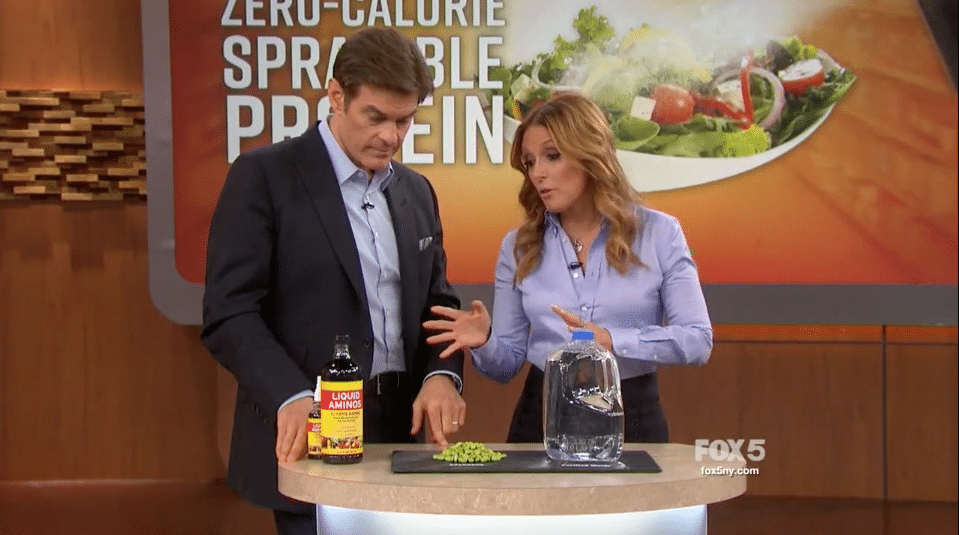
Are Liquid and Sprayable Aminos Worth Adding to Your Diet? Dr. Oz Segment featuring Dr. Kellyann.
Dr Kellyann Petrucci talks Liquid and Sprayable Proteins on the Dr. Oz Show, May 1, 2017 from Kellyann Petrucci on Vimeo.
What are liquid and sprayable proteins, also known as liquid aminos?
- Liquid aminos are usually used as a soy sauce alternative (as well as a tamari alternative). It gives food a yummy, salty taste!
- Liquid aminos are gluten-free.
- Most Liquid aminos are made from non-GMO soybeans (make sure to check the packaging of the brand you're considering!). About 85 percent of American grown soybeans are genetically modified.
- No table salt or preservatives are added to liquid aminos.
- Liquid aminos provide a small amount of protein (310 mg per ½ teaspoon). The Recommended Daily Allowance (RDA) is about 56 grams a day of protein a day for men and about 46 grams a day for women, so they are not a viable protein substitute.
- Liquid aminos are rich in 16 out of the 20 amino acids – ½ a teaspoon has 290 mg of amino acids.
Should we add these to our diets?
These have a nice flavor. If you’re using this as a soy sauce alternative – non-GMO and the amino acids and protein are benefits – and don’t have a soy intolerance, you should be fine. I actually consider soy a dietary toxin, so if you are looking to lose weight, I don't recommend this product. If you are looking to maintain weight and want to experiment with adding a little bit of soy back into your diet, this product might be a great fit for you. The spray can be used on sushi, salads, soups or anywhere you want that salty taste. The spray has zero calories, and a couple of sprays are really all you need to add flavor.
Is there hidden MSG in liquid aminos?
MSG occurs naturally and organically in many foods, such as mushrooms, tomatoes, Parmesan cheese, and soybeans. Since liquid aminos are made from soybeans, there is naturally occurring MSG in most brands.
How much sodium is in liquid aminos versus traditional soy sauce?
1 teaspoon of the best selling brand of liquid aminos contains 320 mg of sodium. 1 teaspoon of traditional soy sauce contains about 291 mg of sodium, so soy sauce has this product beat. If you're just applying 1-2 sprays to your food, you won't be ingesting too much sodium, but certainly ask your doctor if he or she has given you a low sodium recommendation.
What do amino acids do for our body?
- Amino acids play central roles both as building blocks of proteins.
- Humans can naturally produce 10 of the 20 amino acids. The others must be supplied in food because the human body lacks the enzymes to make them. Adding amino acids to your body is a good way to do this.
- The human body does not store excess amino acids for later use, so we must consume essential amino acids every day through food. Bone Broth and other animal products give us most of what we need, but liquid aminos can provide these as well.
How much protein are you really getting with liquid aminos?
Very little: ½ a teaspoon has 290 mg of amino acids and 310 mg of protein. A 4-ounce chicken breast contains 35 grams of protein. Put that into perspective: that’s 35,000 mg of protein: 113 times the amount in that ½ teaspoon of liquid aminos.
What are some other ways to get amino acids?
- A GREAT alternative I love (similar taste without the soy) is coconut aminos, made from coconut and not soy, but with a wonderful flavor. Coconut aminos don’t provide the protein liquid aminos do (although coconut sap – from which they are derived – is an abundant source of 17 amino acids), but they are gluten free, soy free, and non-GMO. They provide a similar flavor that you get with liquid aminos.
- Branched-chain amino acids (BCAAs) – a supplement in powder or capsule form
- Free-form amino acids – a supplement provided all essential amino acids
- Protein-rich foods like poultry, seafood, nuts, seeds, and legumes
Keep thinking Big and living BOLD!








